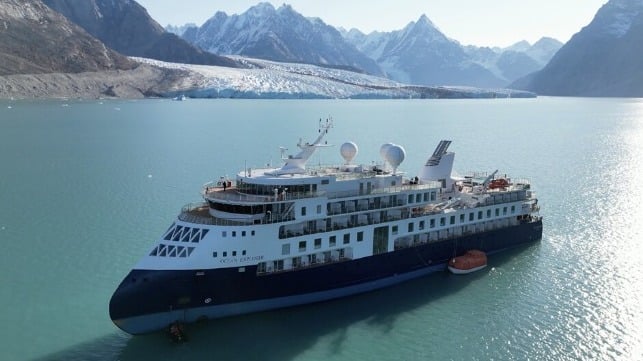By Michael Grey*

There were some exciting times in the Far North in September. For a start, the passengers aboard the small expedition cruise ship Ocean Explorer, getting up close and personal to glaciers on the coast of north-east Greenland, found that they were unable to go anywhere after their ship ran aground in the spectacular Alpefjord. There they remained for five days, with the nearest Danish patrol ship scrambled from 1200 miles away, although they would have been comforted by the fact that they were in sheltered waters, if anywhere in that latitude can be so described. In the event, the weather stayed kindly and as if from nowhere, the research ship Tarajoq popped up to help haul the ship off the shelf.
It was a reminder that in these remote places, you cannot completely guarantee the depth of water or the accuracy of the charts, and that if you insist on going into such latitudes, you will be largely on your own, far from any meaningful assistance. A few years ago, I was present at a fascinating presentation by the Norwegian emergency services, which explained the detailed planning they have been required to undertake with the increased numbers of big cruise ships seeking spectacular sights in potentially dangerous places.
The scenario involved the rescue of several hundred people, of the demographic one expects, from an abandoned vessel in conditions of heavy ice and bad weather and it all seemed very scary, involving long distance flying, landing on ice and other hair-raising operations. One just felt relieved that the Norwegians were on the case and hoped that they would not have to undertake the exercise for real, not least because of the sheer numbers aboard some of the larger ships. Ocean Explorer, aground off Greenland, was a mere minnow.
While this was happening, on the Northern Sea Route above Russia, the cape-sized Gingo, fully laden with 164,600 tonnes of ore concentrate, was making a 13 day passage between Murmansk and China, assisted by a couple of nuclear icebreakers. A triumphant photograph of the ship, with the largest cargo ever to have been transported on the NSR was taken by one of the icebreakers, apparently illustrating the ease of such an operation for a ship that was not ice strengthened. Ploughing through the murk, it showed a worrying amount of floating ice, presumably cleared by her atomic friends.
It was also revealed that during this season, at least two other large tankers had made the voyage through the Barents, Kara and Laptev seas, en route to Chinese ports. Neither was apparently ice-strengthened although it might be assumed that the crude cargo would have the protection of double hulls. It was not revealed whether the bulk carrier would have had more than a single skin on the load waterline.
We are being asked to accept that this is now perfectly routine, with the melting ice from climate change making the NSR a perfectly viable alternative for commercial all-year-round navigation. The Russian authorities, who seem in their announcements to be oblivious about the political horrors of the war and sanctions, suggest that the sea route could be carrying up to 200m tonnes by the end of the decade and that transits by non-ice strengthened ships would be routine in the summer.
A must: factor in the fickle weather
You have to hope that they know what they are doing. You only have to read accounts of navigation in these remote and poorly charted areas, to realise that the weather and indeed the climate, are exceedingly fickle. It was only in 1932 that a Soviet icebreaker succeeded in completing the passage and just a year later, a small fleet of ships which set out from Murmansk for Vladivostok, to take advantage of the good ice conditions in August, was crushed by the returning ice, just short of the Bering Strait, and destroyed.
The ice, from all accounts, comes and goes in an unpredictable fashion, hugely prone to weather and wind changes, with the seasons lengthened and shortened without much notice. And despite all the technology, forecasting and the presence of the world’s most powerful icebreakers, you have to be worried that the Russian need to get their oil to market, in the teeth of sanctions, will encourage them to take risks with the environment that should not be taken. It is not that many years ago that they thought it perfectly acceptable conduct to abandon their time-expired nuclear submarines in the Kola Inlet, to rot among their leaking radiation.
It does not take much to punch a hole in a ship that was never designed for high latitudes and low temperatures. You should not count on assurances about “climate change” and its suggestions that these waters are suddenly, and permanently, safer.
(Photo from Joint Arctic Command, Greenland)
*Michael Grey is former editor of Lloyd’s List. This column is published with the kind permission of The Maritime Advocate.


